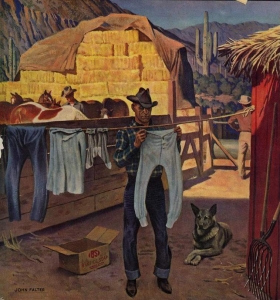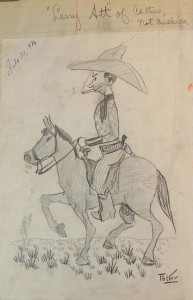
John Phillip Falter (1910-1982)|Cowboy Hanging Out His Laundry|Cover illustration for the Saturday Evening Post (March 1, 1947)
The above title, A Man’s World, typically means that men have been privileged—they might have had better pay, more prestigious jobs, or been aided in their climb by other men. But as we see in this John Falter cover illustration for The Saturday Evening Post from 1947, sometimes a man’s world simply means that there is merely an absence of women. In this SEP cover there appear to be only men inhabitants of this constructed image—even the self-satisfied Shepherd dog, pictured with this front legs crossed, to me exudes a sense of male entitlement and superiority.
It is an image of a man’s world because men are obviously responsible for all aspects of daily living. In the foreground Falter focused on daily activities on the ranch. A ranch hand hangs his freshly washed laundry to dry on a clothes line strung from a thatch-covered barn. At his feet sits an open empty soap box. While his washed blue jeans are simply thrown over the line, the shirt and socks are pinned with straight pins—a clever substitute for clothes pins. These garments appear to belong to the cowboy hanging them due to the obvious bow-legged curve of the long-johns and the jeans on the line echoing the bow-legged stance of the cowboy hanging the wash. The fact that the jeans the cowboy is wearing are folded up into cuffs says to me that there is no one (or no woman) with sufficient needle skills in the community to hem his jeans. Although all three men pictured in this illustration appear neatly turned out, the shirt hung on the line to dry shows clear evidence of hard use: the collar is so frayed that a portion of it is clearly separating from the rest of the shirt. Even as a Nebraska teenager, John Falter was interested in picturing cowboys as we can see in a page from his 1925-26 scrapbook put together when he was a fifteen/sixteen year old high school student in Falls City.*
 The SEP cover cowboys are clearly taking care of their responsibilities. The hides of the horses crowding the corral gleam in the strong sunlight. The wide stiff brims of cowboys’ hats help to shield their eyes from the glare of that strong light. While all three men pictured in this illustration wear similar cowboy hats, each has rolled the brim or pinched the crown so it conforms to their preferred style. The mountain of baled hay has a large tarp over it to protect the precious commodity from wind and scavengers.
The SEP cover cowboys are clearly taking care of their responsibilities. The hides of the horses crowding the corral gleam in the strong sunlight. The wide stiff brims of cowboys’ hats help to shield their eyes from the glare of that strong light. While all three men pictured in this illustration wear similar cowboy hats, each has rolled the brim or pinched the crown so it conforms to their preferred style. The mountain of baled hay has a large tarp over it to protect the precious commodity from wind and scavengers.
Just past a second perimeter of fencing, seen in the painting’s middle ground just beyond the man standing with his back to the viewer, we can clearly see the surrounding mountains and dessert. Beyond the ranch are saguaro cacti—native to the Sonoran Desert located in Arizona, the Mexican state of Sonora and in a small part of Baja California. Despite the fictional evidence of TV and movie westerns, there are no wild saguaros in Texas, Colorado, Utah, New Mexico, or Nevada. These cacti are slow to develop and long lived. If you can zoom in on the image of the saguaro cacti, you can see that various holes appears to have been drilled into it’s pulpy flesh. Various birds excavate nests in these long-lived cacti. When the initiators move out other birds, (owls and purple martins) may move in. Despite the harshness of the high desert, men and animals have long sought places to create their own domestic havens.
*Deb Arenz, Senior Museum Curator “The Start of an Illustrious Career” at blog.nebraskahistory.org (January 1st, 2011).
January 27, 2011
By Joyce K. Schiller, Curator
Rockwell Center for American Visual Studies, Norman Rockwell Museum






